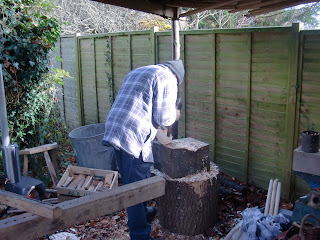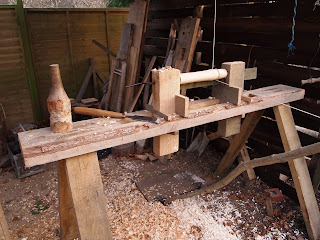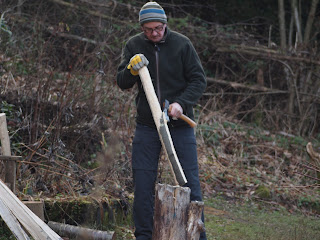As you will notice it's been a long time since I've updated the blog - mainly due to moving out of the Wakehurst cottage into our first house last year, which seems to have taken up a lot of our time! Because the house needed a lot of serious updating, plus it didn't come with a ready-made suitable bodging area, my usual bodging was put on the backburner.
Though we did manage to get out to a few events in 2013... including of course the Bodgers Ball in Cambridge though we didn't participate as actively as usual, as having just moved house all the woodworking gear was still packed away. We made it to Lammas in July in Eastbourne where finally I'd managed to get my things together, and I also joined the Pelicans group at Carisbrooke Castle for a hot busy weekend in August where I managed to sell most of my stock. We also enjoyed a very chilled weekend at the Teddy Bears picnic in August hosted by the Abbotts in their lovely Essex wood. And then of course there was no stopping us going to Bentley wood fair in September, probably our favourite event of the calendar alongside the Ball.
So back to bodging domestics, in November I started to replace the dilapidated back garden shed with my old shed which now serves as my bodging workshop. But twisting my ankle half way through putting it up put this back by about 3 months which was very frustrating.
Of course having a pole lathe in a standard shed doesn't fit, so I had to workout how to raise the shed to give me the height needed for my bowl lathe by an extra 10" or so; I've done this by not using the floor and standing the shed on 6" x 2" oak boards all the way around on oak rounds at the corners which are sunk into the ground by about 2'. This does mean I have to step over the threshold to get into the shed. While doing this, I also reinforced the roof and before adding the felting I stapled down some breathable waterproof membrane to keep the structure dry. Also I've put guttering all around linked up to six slimline water butts to take the water away from the shed footings, as the floor is now just a dirt floor.
Obviously the shed (10 x 8') is not as generous in space as a proper workshop would be so I've had to design a dual purpose lathe to save space. So I have decided not to put my favourite lathe (Lailey-style) into the shed as it takes up a little too much room, and the permanent lathe I have in there now acts as both a bowl/ spindle lathe. With this, the idea is to have the bed staying in a permanent space-economical position with the ability to use two different treadles depending on what I'm using it for. So for spindle turning I have my back against the wall with the spindle treadle pointing towards the centre of the shed, but when making bowls I stand on the other side of the lathe in the centre of the shed with the bowl treadle located underneath and behind me. Also of course I have two sets of poppets for spindle or bowl turning, and two separate bungees anchored from a frame above the bed.
Bowl lathe set up
Spindle lathe set up
Bowl and spindle lathe bungee


























